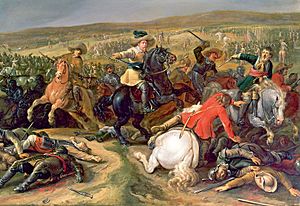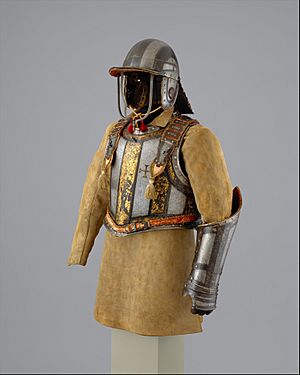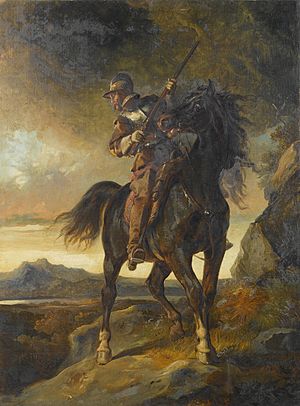Harquebusier facts for kids
A harquebusier was a common type of cavalry soldier in Western Europe during the early to mid-17th century. These soldiers were known for using a kind of carbine gun called a "harquebus." In England, "harquebusier" was the official name for them, but people often just called them 'cavalry' or 'horse.' In other places, they had different names, like Ringerpferd or Reiter in Germany, and lätta ryttare in Sweden.
Contents
How Harquebusiers Developed

The harquebusier cavalry started in France, according to a military book from 1632. These soldiers were first known for their carbine, which was a lighter version of the infantry's "arquebus" gun. In the late 1500s and early 1600s, harquebusiers were meant to support heavier cavalry. This included soldiers like the demi-lancer or those armed with pistols, such as the cuirassier and reiter.
By the middle of the 17th century, the harquebusier became the main type of cavalry across Western Europe. Their role changed from just using firearms to being strong in close combat. This big change was led by Gustavus Adolphus of Sweden in the 1620s and 1630s. Sweden was not a rich country, so they couldn't afford many expensive cuirassiers. This meant they had to use lighter cavalry for powerful attacks.
The Swedish cavalry's success in the Thirty Years War made other countries copy their methods. Gustavus Adolphus also changed how cavalry lined up. Instead of six to ten ranks deep for pistol attacks, he used three ranks for sword-based charges.
Later, harquebusiers were also used for powerful charges by leaders in the English Civil War. Prince Rupert of the Rhine and Oliver Cromwell used them to charge aggressively with swords. Their guns became less important. By the 1620s, even cavalry without carbines could be called "harquebusiers." This was because of the type and style of their armour. During the English Civil War, all cavalry not equipped as cuirassiers or carrying a lance were called harquebusiers.
What Harquebusiers Wore and Carried
A harquebusier usually carried a carbine gun, which was hung from a strap across their body. They also had pistols in their saddle holsters and a strong, straight sword. Some harquebusiers also carried a horseman's poleaxe or pick. These were weapons with an axe or hammer head and sharp spikes to pierce armour.
A typical harquebusier wore an iron cuirass, which included a breastplate and a backplate. They also wore an open-faced helmet, like a lobster-tailed pot. Some soldiers who cared about fashion might wear a wide-brimmed felt hat instead of a helmet. They often wore a hidden iron skullcap underneath for protection. In England in 1629, a harquebusier's armour cost much less than a cuirassier's armour.
Richer harquebusiers might wear a buff coat (a thick leather coat) under their armour. They also wore a metal gauntlet to protect their hand that held the horse's reins. Tall riding boots that reached the thigh were also common. These were often made of thick leather too.
How Harquebusiers Were Organized
Harquebusiers were grouped into troops, and several troops formed a regiment. The New Model Army in England is a good example of how they were organized. Each troop was supposed to have 100 cavalrymen led by a captain. Six troops made up a regiment, which was led by a colonel. Regiments were usually named after their colonel. The colonel and his second-in-command, the major, personally led their own troops.
Sometimes, the number of cavalrymen in a troop was lower than planned, especially during battles. Some regiments also had more troops than usual. Important commanders often had a special 'lifeguard' unit. For example, Prince Rupert had a regiment of ten troops plus a lifeguard of 150 men. Oliver Cromwell's regiment had fourteen troops.
How Harquebusiers Fought
Different countries used harquebusiers in slightly different ways in battle. The French often fired their carbines or pistols first, then attacked with swords. The Swedish and Royalist English cavalry charged directly with their swords, saving their guns for close fighting. The Parliamentarian English cavalry used firearms during their charges until later in the Civil War. However, by the time of the New Model Army, they mostly adopted the direct sword charge.
The Royalists, led by Prince Rupert, started the Civil War using a three-ranks-deep formation, like the Swedes. But the Parliamentarians kept a six-deep formation until late 1643 or early 1644. A cavalry unit in a shallow formation could outflank (go around the side of) a similar-sized unit in a deep formation. This was a big advantage. The Swedes and Royalist horse usually charged quickly. The Parliamentarian Ironsides charged at a slower pace, keeping their soldiers close together to hold their formation.
In England, many harquebusiers didn't even use a carbine. A book from 1661 called Militaire Discipline said: Many troops and regiments only with sword and pistol armed, their encounterings being not after the ancient manner of firing at a distance and wheeling off, which hath been found to be of dangerous consequence, but to fire at near distance their swords hanging at their wrists by a string, and with their sword points charging through adverse troops. This means they charged close, fired their pistols, and then fought with swords.
Why Harquebusiers Disappeared
The name "harquebusier" slowly stopped being used as armour became less common. The heavily armoured cuirassier also disappeared. Harquebusiers became part of the general "horse" or "cavalerie" (cavalry) in the early to mid-18th century. Many British army cavalry regiments that started as harquebusiers eventually became dragoons.
In the late 1600s, armour and the buff coat were used less and less. Helmets were replaced by felt hats and uniform coats. For example, in 1688, all the armour used by the Oxford Blues regiment (which later became the Royal Horse Guards) was put away before they went to war.
Different parts of the harquebusier's equipment disappeared at different times. The doglock carbine was replaced by the "true" flintlock gun in the late 17th century. Cuirasses went in and out of style during the 18th century. The lobster-tailed pot helmet was not popular in most countries by 1700. However, the Austrian army kept this type of helmet for its cuirassiers until the 1780s, especially when fighting the Ottoman Turks.
See also
- Dragoon
- Petronel
- Carabinier






